Just a bit more on male-female responses
Just a bit more on male-female responses
Why so many females?
Interestingly 70% of all respondents thus far have clicked female ( total n = 813). I have no data (does anyone?) on the total number of aid workers that read English and certainly no clear idea who might have been aware of this survey. But even if only a representative percentage of females responded (i.e., if the English reading humanitarian aid worker world is 70% female), this is perhaps noteworthy.
I conducted two international surveys (very much like this one) of self-described non-believers -atheists- in 2008 and 2012 and generated over 8,000 responses for each. Having done the research I am fairly confident in supporting the statement that atheists are more or less equally represented in the population, though in both international surveys the respondents were disproportionately male -68%. When I referenced the literature on Internet based surveys and response rates, 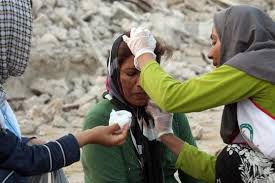 the general consensus (stereotype?) was that males were just ‘more likely to be on the Internet (read: tech savvy) and willing to respond.’ Regarding the 70% female representation in our data (that may or may not the actual proportion in the ‘real world’ of aid workers), I offer no conclusions other than I find it positive that female aid workers are so willing to respond. I hope the same is the case as we roll out Spanish, Arabic and French versions soon, hopefully generating a larger sample of local aid workers (now a paltry 5% of our total sample).
the general consensus (stereotype?) was that males were just ‘more likely to be on the Internet (read: tech savvy) and willing to respond.’ Regarding the 70% female representation in our data (that may or may not the actual proportion in the ‘real world’ of aid workers), I offer no conclusions other than I find it positive that female aid workers are so willing to respond. I hope the same is the case as we roll out Spanish, Arabic and French versions soon, hopefully generating a larger sample of local aid workers (now a paltry 5% of our total sample).
Open ended response percentages
I was curious if there was a difference in the response rate of males and females to the open-ended questions. The survey includes 18 questions allowing for respondents to expand on specific questions. Females were ever so slightly overrepresented in these comments with just over 71%. Looking at all of the responses, females were just a bit more overrepresented responding to Q34 at 74%, Q36 at 74%, Q38 at 75%, Q41 at 74%, and Q52 at 75%.
Q’s 34, 36, and 38 were in the section of questions asking respondents how difficult it is to explain their aid work activities to various people:
- Q34 “Please elaborate on the response you gave to the question above regarding explaining your job to adult family members.”
- Q36 “Please elaborate on the response you gave to the question above regarding explaining your job to your significant other.”
- Q38 “Please elaborate on the response you gave to the question above regarding explaining your job to non-adult family members.”
Q41 asked, “Please use the space below to elaborate how your gender has or has not been a factor in your humanitarian aid work experience.” Q52 was “Please use the space below to expand on your answers to the two previous questions regarding your views on the relationship between the “home office” and the “field.”
None of these numbers are so different from the male response rate to merit any conclusions, to be sure.
The final question of the survey asked, “Please use the space below to share your feelings about any of the above questions.” and the female response rate was ‘only’ 62%, i.e., females are under represented in feeling like that wanted at add one last word.
Explaining your job
As you can see below, there was a small but consistent difference between males and females on the questions asking about explaining aid worker life to adult and non-adult family members and to significant others.
Q33. “Which statement below best describes your ability to explain to non-aid worker non-significant other adult family members the nature of your job?”
Q35 Which statement below best describes your ability to explain to non-aid worker significant other the nature of your job?
Q37: “Which statement below best describes your ability to explain to non-adult family members the nature of your job?”
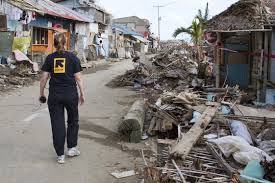 These results overall indicate that many aid workers have a hard time articulating to those in their lives what they do for a living, with explaining to significant others being the easiest, adult family members a bit harder, and non-adults the hardest.
These results overall indicate that many aid workers have a hard time articulating to those in their lives what they do for a living, with explaining to significant others being the easiest, adult family members a bit harder, and non-adults the hardest.
One wonders about all of the aid workers who do not have significant others and the fact that they can only articulate a general sense of what they do. I would hazard the fact that many aid workers are very adept at compartmentalizing their lives is certainly supported by our data.
Does sex matter?
One of the more interesting questions -and set of results- on the survey was Q40 “To what extent has your gender been a factor in your humanitarian aid work experience?” Perhaps not surprisingly, these results included the biggest differences between males and females in the entire survey. Take a look below:
Though the numbers are fairly close, in the response “not at all”, over 20% of the males responded “has been a very positive factor” but just over 8% of the females indictated the same. The contrast is even more extreme for the “been a moderately negative factor” with nearly 40% of the choosing this response compared to only about 6% of the males. In a later post I will unpack the open ended responses to this question -268 females have responded-, but for now one can tentatively conclude that, yes, the perceived gender of an aid worker does matter a great deal.
Feedback and comment
So, all for now. Please let mew know what you think or if you have any questions. Email me with your thoughts.
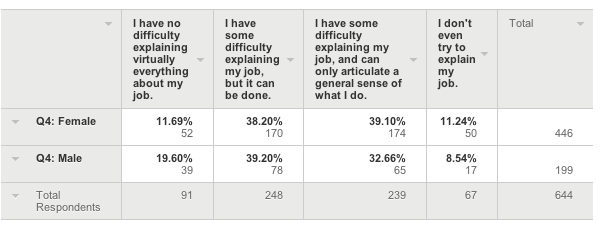
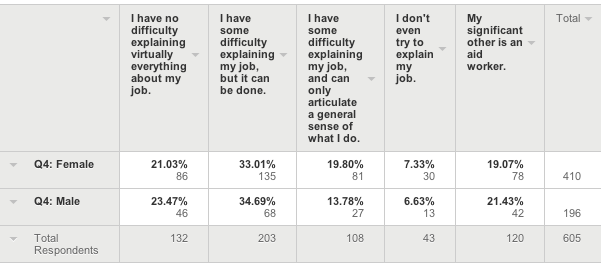
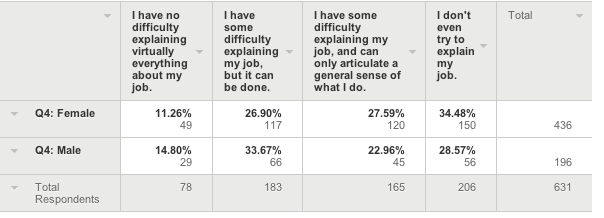

 Follow
Follow